A federal agency responsible for regulating vehicle safety features has taken initial steps toward mandating technology in cars and light trucks that would automatically prevent intoxicated drivers from starting their vehicles.
The National Highway Traffic Safety Administration (NHTSA) made the announcement this week, though any resulting changes to vehicles are still years away.
The primary reason is that the technology NHTSA aims to implement is still under development.
However, the move underscores growing concerns in Congress which directed NHTSA to examine the technology and among states regarding the lack of progress in recent years in deterring impaired driving.
“It is tragic that drunk driving crashes are one of the leading causes of roadway fatalities in this country and far too many lives are lost,” stated Polly Trottenberg, Deputy Secretary of the U.S. Department of Transportation.
“The Advance Notice of Proposed Rulemaking we are announcing today is the first step toward a new safety standard requiring alcohol-impaired-driving prevention technology in new passenger vehicles.”
Alcohol use remains a significant contributor to fatal traffic accidents, alongside speeding and failure to wear seatbelts. According to NHTSA, it plays a role in 31% of all traffic-related deaths.
In 2021, the most recent year for which federal data is available, more than 13,000 people lost their lives in alcohol-related crashes. This translates to one fatality every 39 minutes.
“Concerted efforts by NHTSA, states and other partners to implement proven strategies generated significant reductions in alcohol-impaired driving fatalities since the 1970s when NHTSA records began; but progress has stalled,” the agency stated in its notice.
In the U.S., every state has criminalized driving with a blood alcohol concentration (BAC) of 0.08% or higher. Utah is the only state with a lower threshold, set at 0.05%.
Also Read: 10 Best Muscle Cars That Are Now Worth a Fortune and Still Rising in Value
This stricter limit has shown potential in reducing drunk driving deaths, yet other states have been hesitant to adopt similar measures.
Additionally, most states require individuals convicted of drunk driving to install an alcohol interlock device in their vehicles to prevent operation while intoxicated.
However, the approach outlined by NHTSA in its 99-page notice on Tuesday would take a slightly different direction.
The 2021 infrastructure law instructed the agency to implement “advanced drunk and impaired driving prevention technology” by 2024 provided the technology could passively and accurately determine driver impairment.
While NHTSA is actively researching potential solutions, widespread implementation of the technology remains premature.
“Several technologies show promise for detecting various states of impairment, which for the purposes of this notice are alcohol, drowsiness and distraction,” the agency noted.

“However, technological challenges, such as distinguishing between different impairment states, avoiding false positives, and determining appropriate prevention countermeasures, remain.”
Despite these challenges, Jonathan Adkins, CEO of the Governors Highway Safety Association (GHSA), which represents state traffic safety agencies, emphasized the potential benefits of pursuing such technologies.
“Of the many critical safety provisions of the [2021 infrastructure law], this requirement for alcohol detection technology has the potential to save the most lives on our roads,” he said in a statement.
The notice “is overdue, cannot be finalized soon enough and should remain a top roadway safety priority.”
NHTSA’s research extends beyond alcohol detection to address other dangerous driving behaviors, such as drowsy and distracted driving.
According to the agency, the safety risks associated with distracted driving are particularly significant.
The agency has yet to determine the exact mechanism by which detection systems would operate but suggested that the same technology could be used to monitor alcohol impairment, drowsiness, and distractions.
One possible method involves touch sensors embedded in key vehicle components such as the ignition switch, steering wheel, or gear shift selector that use infrared light to analyze the chemical properties of the driver’s skin, including alcohol concentration.
Another potential approach involves breath detectors capable of analyzing naturally exhaled air to measure BAC levels.
However, NHTSA acknowledged that current breath-based systems are not entirely “passive,” as the infrastructure law requires, since they necessitate an active breath sample from the driver.
“Nearly two-thirds of all alcohol-impaired fatalities involve high blood alcohol levels with a BAC level at or greater than 0.15%,” the agency noted.
“Yet even a small amount of alcohol can affect an individual’s driving ability. In 2020, there were 2,041 people killed in alcohol-related crashes where a driver had a BAC level of .01 to .07.”
Rather than relying solely on BAC, NHTSA is considering systems that analyze vehicle and driver behavior to determine impairment.
Also Read: Top 10 Performance Upgrades That You Can Do On Your Car
These systems could assess whether the driver’s eyes are focused on the road and whether their hands remain on the steering wheel. Additionally, they could monitor braking, acceleration, and steering patterns to detect signs of impairment.
However, this method presents its own set of challenges. Since impairment manifests differently in individuals, and drowsy drivers sometimes exhibit behaviors similar to those of intoxicated drivers, false identifications remain a concern.
The infrastructure law allows NHTSA to implement a combination of different detection systems to address these concerns.
Additionally, the agency noted that several major automakers, including Hyundai, Nissan, Toyota, and Volvo, have already been developing technologies capable of preventing a vehicle from being operated if the driver is deemed too intoxicated to drive safely.

